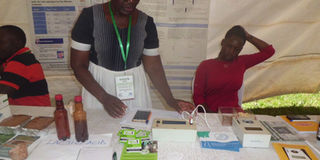Sensor tool to detect harmful fungus

Dr Deborah Wendiro demonstrates how the aflatoxin sensor operates. Photos by Lominda Afedraru
What you need to know:
- Farmers processing produce prone to aflatoxins now have the privilege of using homemade testing equipment, writes Lominda Afedraru.
- A complete detoxifying sensor unit will cost between Shs2m to Shs5m depending on the make. The equipment is ready for use but the scientists have to finalise modalities of patenting it before embarking into massive production for commercialisation to farmers.
Farmers growing crops such as maize, cassava, beans and groundnuts among others are likely to experience a challenge of aflatoxin infestation arising from poor processing and storage facility.
The above crops if poorly stored usually end up growing fungi and people engaged in agro processing will go ahead to process these farm produce which end up in the market.
A case in point is groundnut containing aflatoxin which is grinded and sold for making groundnut stew. Another is cassava flour containing aflatoxin which is sold in open markets.
Others are beans and cow peas which have overstayed in stores accumulating fungus and later dried and sold in open markets.
Once these produce are cooked and consumed by humans they end up becoming sick and too much consumption of food containing aflatoxin may lead to death.
Aflatoxins
Aflatoxins are defined as secondary metabolites produced by fungal species called Aspergillus flavus and A. parasiticus.
They are highly toxic and have been designated by scientists as poisonous to human health.
Factors such as temperature, humidity, moisture, soil properties, poor storage facility as well as nutrient composition of the food produced influences fungal growth leading to aflatoxin production in cereals and legumes.
Consumption of such contaminated food ingredients could expose consumers to diseases such as cancer.
Remedy
As such scientists from Uganda Industrial Research Institute (UIRI) in collaboration with their counterparts at Makerere University College of Agricultural and Environmental Sciences (CAES) have invented a detoxifying sensor tool which can detect the amount of aflatoxin in a specific quantity of farm produce.
Speaking to the head of micro biology and biotechnology at UIRI Dr Deborah Wendiro, she explained that the idea of inventing the sensor arose from a concern of farmers growing cassava in West Nile who were tasked by World Food Programme to test aflatoxin contamination rate before selling the flour.
The farmers belonging to West Nile cassava producers association used to bring samples of their cassava flour for testing at Makerere School of Food Technology, Nutrition and Bioengineering which is costly. With the invention of the sensor, things will be made easy because the gadget is portable.
How the sensor operates
Dr Wendiro explains that the equipment comprises the sensor case with a provision for loading an ordinary battery to enable operation of the equipment. This therefore means it can be used by farmers in rural areas where there is no electricity since it does not require hydroelectric power for powering. It contains the sensor which is connected to a thin layer of electrical wire. Once it is turned on from the switch which is attached to the case, it will start detecting the aflatoxin level in a particular agricultural produce.
The sensor contains antibodies which react to microbial organism. What farmers are advised to do is get antibodies for aflatoxin which is uploaded to the sensor.
It is advisable to preserve the senor in a glass filled with water. For the case of cassava, a farmer can weigh one kilogramme of cassava flour which is mixed in ethanol liquid and the sensor is inserted in the liquid mixture. The aflatoxin level in the cassava will be read automatically. This applies to any other farm produce. Dr Wendiro notes that the equipment has been tested to comply with the internationally recommended sensor performance standards. Every country recommends different aflatoxin levels for their agricultural produce. In Europe, countries recommend 20 micro grammes per gramme. The figure for Uganda is slightly higher than this.
The scientists are upgrading the invention with a design of connecting the sensor to a mobile phone.
It will enable farmers to take readings of aflatoxin levels directly from their phones rather than carrying the equipment with its case.
Costs
A complete detoxifying sensor unit will cost between Shs2m to Shs5m depending on the make. The equipment is ready for use but the scientists have to finalise modalities of patenting it before embarking into massive production for commercialisation to farmers.




